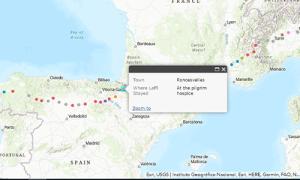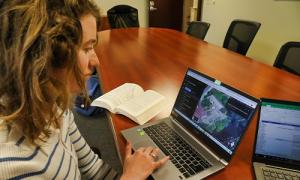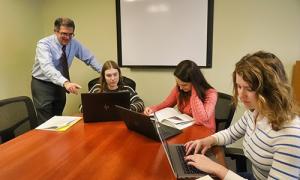
The Camino de Santiago, known in English as the Way of St. James, is a famous Christian pilgrimage route ending at the cathedral of Santiago de Compostela in Galicia, Spain. Two years ago, Professor Sean Perrone of the History Department began creating a map of various buildings along the Camino such as bridges, churches, hospitals, and monasteries. Using ArcGIS, an interactive web map was created with various layers showcasing different buildings as they appeared along the Camino from the ninth century and before all the way to the seventeenth century.
Beginning this academic year, Perrone sought to add further details to research spreadsheets in order to create richer, more complete maps of the Camino’s infrastructure, and hired Sarah Helmar ’22, Madison Lessard ’22, and Frances Bush ’24 to work on the project by processing more information from secondary and online primary sources.
Perrone explained that he hopes “to link granular details on various monasteries and hospitals to the Camino’s physical geography and to create a ‘deep map’ of the infrastructure over time.”

The students involved have each taken on major roles in the research. Frances Bush, a sophomore history major, has been charged with collecting data on various hospices and hospitals along the Camino and incorporating information such as the name, latitude and longitude, type of architecture, and topography of the environment around the building to provide more detailed descriptions of the history surrounding the Camino.
Madison Lessard, a senior history and theology double major, also worked on the project when it began two years ago. She recently compiled information from Domenico Laffi’s 1670 trip from Italy to Santiago de Compostela. Using this information, Madison logged descriptions of hospitality along the Camino, which is helping to enrich the map with firsthand details of the route.
Sarah Helmar, a senior history major, came to the project with the desire to have a “unique experience that will help build skills for after graduation.” After taking a course on Medieval Spain with Professor Perrone, Sarah became interested in the Camino de Santiago and is now working on a new spreadsheet for the project. Using the online index of the Cathedral Archives of Burgos, Sarah has gathered information on hospitals in the city of Burgos and the surrounding area to create a rough translation on the descriptions of each building for easy categorizing and searching.

The goal of this “is to create a spreadsheet that will allow us to trace over time the property transactions of the various hospitals, privileges granted to those hospitals by different kings, and other administrative details concerning the hospitals,” Perrone said.
In her time with the project, Helmar feels that she has improved her “skills with technology, specifically in Excel spreadsheets” and has sharpened her “skills with historical analysis in the process.” When asked why she felt this experience was valuable to her, Helmar explained that this experience has taught her, “to understand how people interacted during this time and shine a light on people’s experiences that we do not always talk about. It is valuable and important that we have access to this information, and I am honored to be a part of a project that is creating a more accessible and technological way of studying the past.”
The continuation of this research was made possible by the Phi Alpha Theta Faculty Advisor Grant, which Perrone received for his project “Building a Database on Monasteries and Hospitals along the Camino de Santiago for Spatial Analysis.” Using the grant, Perrone hired Helmar and Bush to further populate the existing data and come closer to realizing the “deep map” he had envisioned for the project.
“This project will help to make the digital humanities an ongoing concern at the College and therefore foster the development of innovative, interdisciplinary research skills in our students as they prepare for future careers,” shares Perrone.
